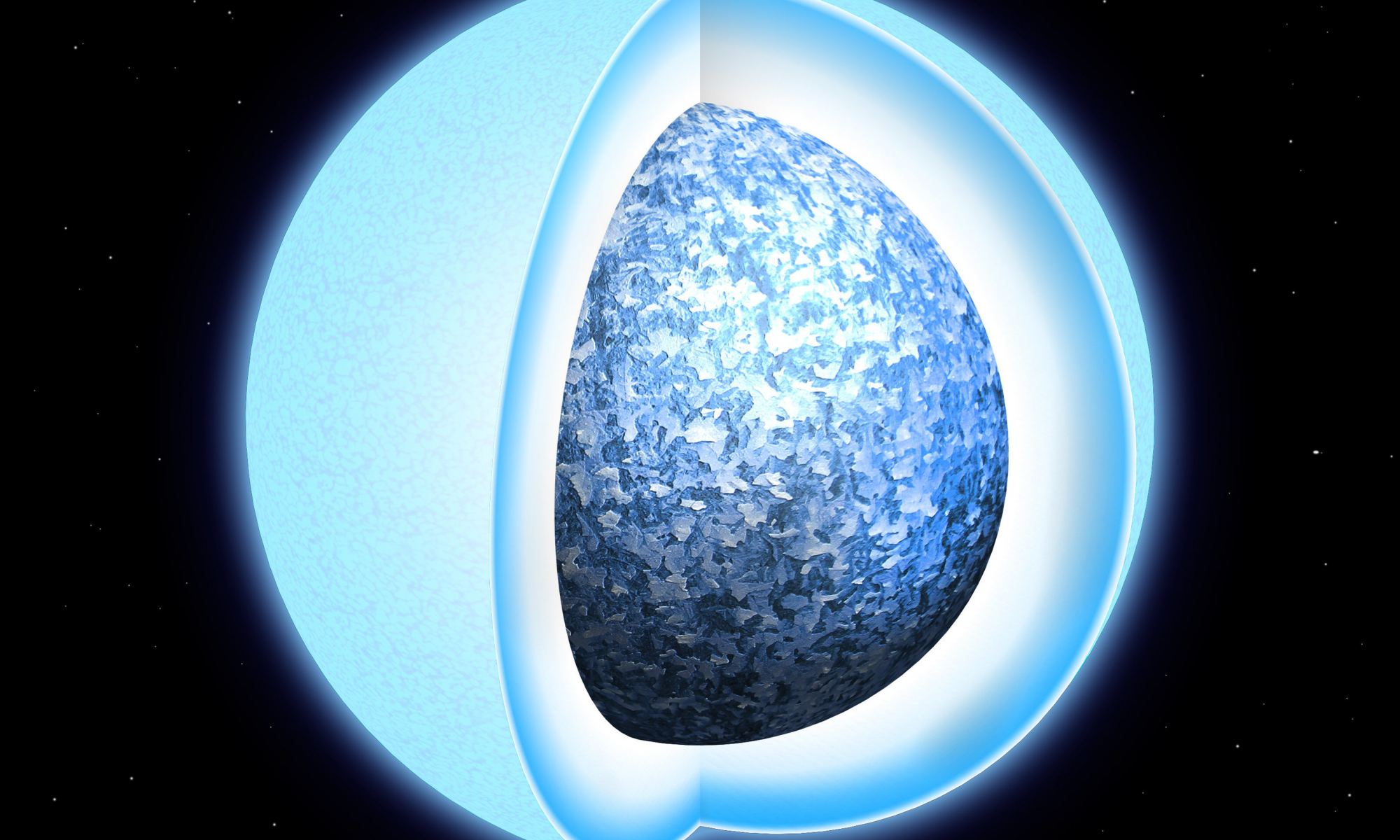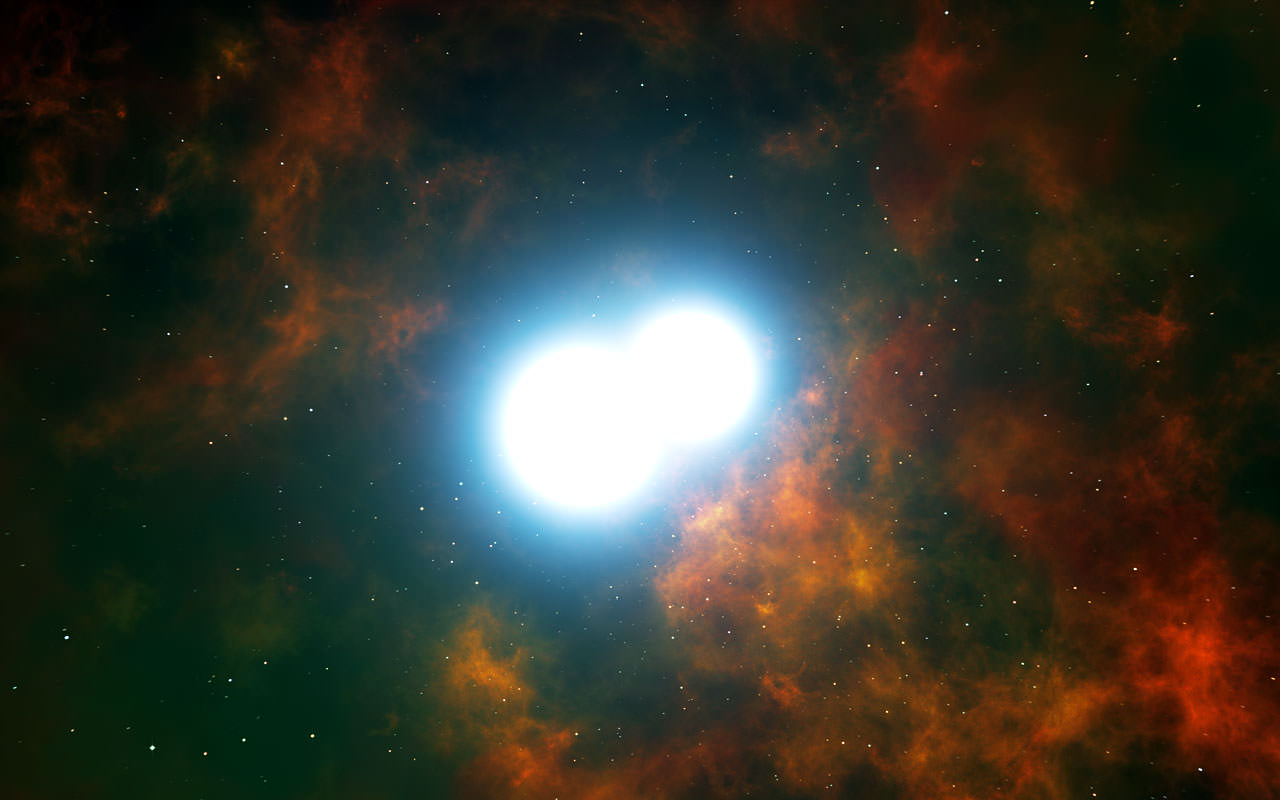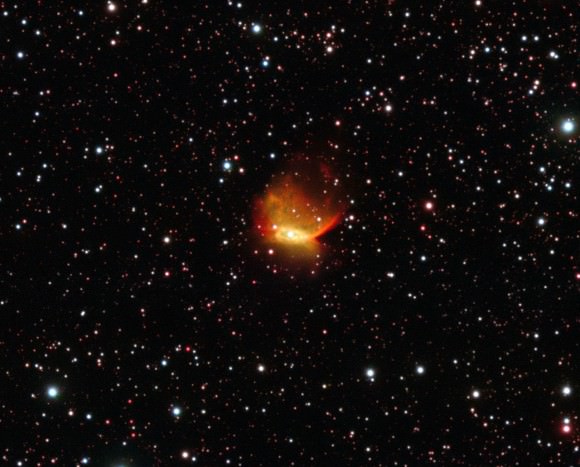A white dwarf isn’t your typical kind of star. While main sequence stars such as our Sun fuse nuclear material in their cores to keep themselves from collapsing under their own weight, white dwarfs use an effect known as quantum degeneracy. The quantum nature of electrons means that no two electrons can have the same quantum state. When you try to squeeze electrons into the same state, they exert a degeneracy pressure that keeps the white dwarf from collapsing.
Continue reading “Strange Green Star is the Result of a Merger Between two White Dwarfs”Scientists Recreate the Density of a White Dwarf in the Lab

The density of a white dwarf star defies our imagination. A spoonful of white dwarf matter would weigh as much as a car on Earth. Atoms within the star are squeezed so tightly that they are on the edge of collapse. Squeeze a white dwarf just a bit more, and it will collapse into a neutron star. And now, we can recreate the density of a white dwarf within a lab.
Continue reading “Scientists Recreate the Density of a White Dwarf in the Lab”Bizarre Star Could be the Result of Two White Dwarfs Merging Together
Stars live and die on epic time scales. Tens of millions of years, hundreds of millions of years, even billions of years or longer. Maybe the only thing that surpasses that epicness is when two dead stars join together and come back to life.
Continue reading “Bizarre Star Could be the Result of Two White Dwarfs Merging Together”This Star Has Been Going Nova Every Year, for Millions of Years
A nova star is like a vampire that siphons gas from its binary partner. As it does so, the gas is compressed and heated, and eventually it explodes. The remnant gas shell from that explosion expands outward and is lit up by the stars at the center of it all. Most of these novae explode about once every 10 years.
But now astrophysicists have discovered one remnant so large that the star that created it must have been erupting yearly for millions of years.
Continue reading “This Star Has Been Going Nova Every Year, for Millions of Years”Two Stars On A Death Spiral Set To Detonate As A Supernova

Two white dwarfs circle around one other, locked in a fatal tango. With an intimate orbit and a hefty combined mass, the pair is ultimately destined to collide, merge, and erupt in a titanic explosion: a Type Ia supernova.
Or so goes the theory behind the infamous “standard candles” of cosmology.
Now, in a paper published in today’s issue of Nature, a team of astronomers have announced observational support for such an arrangement – two massive white dwarf stars that appear to be on track for a very explosive demise.
The astronomers were originally studying variations in planetary nebulae, the glowing clouds of gas that red giant stars throw off as they fizzle into white dwarfs. One of their targets was the planetary nebula Henize 2-428, an oddly lopsided specimen that, the team believed, owed its shape to the existence of two central stars, rather than one. After observing the nebula with the ESO’s Very Large Telescope, the astronomers concluded that they were correct – Henize 2-428 did, in fact, have a binary star system at its heart.

“Further observations made with telescopes in the Canary Islands allowed us to determine the orbit of the two stars and deduce both the masses of the two stars and their separation,” said Romano Corradi, a member of the team.
And that is where things get juicy.
In fact, the two stars are whipping around each other once every 4.2 hours, implying a narrow separation that is shrinking with each orbit. Moreover, the system has a combined heft of 1.76 solar masses – larger, by any count, than the restrictive Chandrasekhar limit, the maximum ~1.4 solar masses that a white dwarf can withstand before it detonates. Based on the team’s calculations, Henize 2-428 is likely to be the site of a type Ia supernova within the next 700 million years.
“Until now, the formation of supernovae Type Ia by the merging of two white dwarfs was purely theoretical,” explained David Jones, another of the paper’s coauthors. “The pair of stars in Henize 2-428 is the real thing!”
Check out this simulation, courtesy of the ESO, for a closer look at the fate of the dynamic duo:
Astronomers should be able to use the stars of Henize 2-428 to test and refine their models of type Ia supernovae – essential tools that, as lead author Miguel Santander-García emphasized, “are widely used to measure astronomical distances and were key to the discovery that the expansion of the Universe is accelerating due to dark energy.” This system may also enhance scientists’ understanding of the precursors of other irregular planetary nebulae and supernova remnants.
The team’s work was published in the February 9 issue of Nature. A copy of the paper is available here.
Chandrasekhar Limit
[/caption]
When a human puts on too much weight, there is an increased risk of heart attack; when a white dwarf star puts on too much weight (i.e. adds mass), there is the mother of all fatal heart attacks, a supernova explosion. The greatest mass a white dwarf star can have before it goes supernova is called the Chandrasekhar limit, after astrophysicist Subrahmanyan Chandrasekhar, who worked it out in the 1930s. Its value is approx 1.4 sols, or 1.4 times the mass of our Sun (the exact value depends somewhat on the white dwarf’s composition how fast it’s spinning, etc).
White dwarfs are the end of the road for most stars; once they have used up all their available hydrogen ‘fuel’, low mass stars shed their outermost shells to form planetary nebulae, leaving a high density core of carbon, oxygen, and nitrogen (that’s a summary, it’s actually a bit more complicated). The star can’t collapse further because of electron degeneracy pressure, a quantum effect that comes from the fact that electrons are fermions (technically, only two fermions can occupy a given energy state, one spin up and one spin down).
So what happens in the core of a massive star, one whose core weighs in at more than 1.4 sols? As long as the star is still ‘burning’ nuclear fuel – helium, then carbon etc, then neon, then … – the core will not collapse because it is very hot (electron degeneracy pressure won’t hold it up ’cause it’s too massive). But once the core gets to iron, no more burning is possible, and the core will collapse, spectacularly, producing a core collapse supernova.
There is a way a white dwarf can go out with a bang rather than a whimper; by getting a little help from a friend. If the white dwarf has a close binary companion, and if that companion is a giant star, some of the hydrogen in its outer shell may end up on the white dwarf’s surface (there are several ways this can happen). The white dwarf thus adds mass, and every so often the thin hydrogen envelope blows up, and we see a nova. One day, though, the extra mass may put it over the limit, the Chandrasekhar limit … the temperature in its center gets high enough that the carbon ‘ignites’, the ‘flame’ spreads throughout the star, and it becomes a special kind of supernova, a Ia supernova.
For more technical details of the Chandrasekhar limit, Richard Fitzpatrick of the University of Texas at Austin has an online Thermodynamics & Statistical Mechanics course, which includes a page on the Chandrasekhar limit.
Supernovae are very important to astronomy, so you won’t be surprised to learn that there are lots of Universe Today stories on the Chandrasekhar limit! Some examples: White Dwarf Theories Get More Proof, White Dwarf “Close” to Exploding as Supernova, and Colliding White Dwarfs Caused a Powerful Supernova.
Astronomy Cast Episode 90 (The Scientific Method) includes a look at how Chandrasekhar worked out the limit that now bears his name, and Where Do Stars Go When They Die? also covers this topic.
References:
Wikipedia
http://www.bluffton.edu/~bergerd/NSC_111/stars.html




